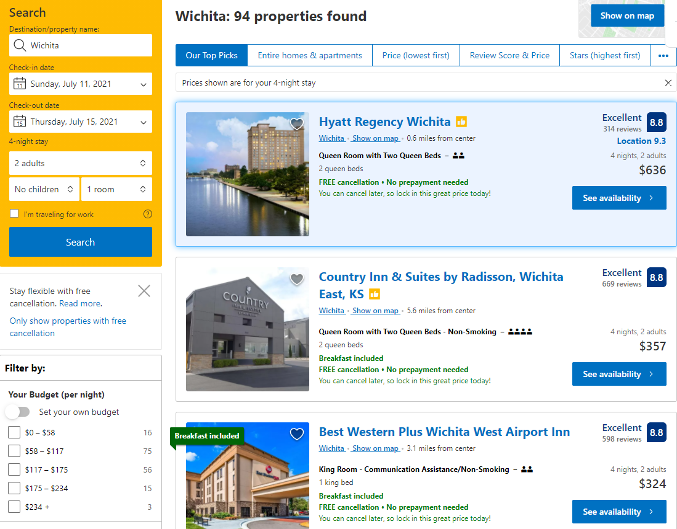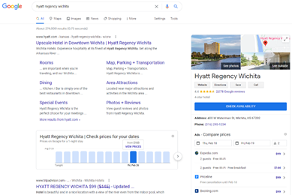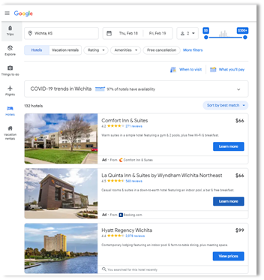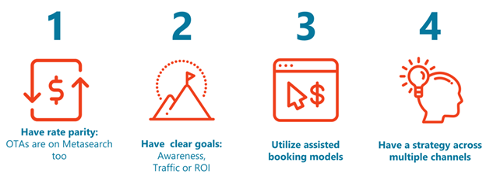Myth-Busting Your Meta – Part 1: New Customers vs. Channel Shift
By Dean Schmit, Founder Base Camp Meta
“The more things change, the more they stay the same.” That phrase was coined by French writer Jean-Baptiste Alphonse Karr in 1849. The quote has largely held true over the years, even when it comes to digital marketing.
We do not need to tell anyone that 2020 has changed all the rules, and especially when it comes to digital marketing in hospitality. A plethora of content is available on these topics, however we wanted to circle in on a particular topic – Metasearch.
Metasearch marketing for hospitality has been around since Kayak was first launched back in 2004. The medium really started gaining ground in about 2012 with Google becoming a major player and growing to become the most significant of the group.
The prominence of Google Hotel Ads has even resulted in some cannibalizing of their own PPC/SEM traffic over the years. Not to be confused, Google did not lose money because of it, but rather saw funds transitioning to other forms of marketing.
That said, it is only reasonable to ask if metasearch channels actually drive incremental revenue for hotels, or if they are merely shifting the revenue stream from other sources? The simple answer is “It can do both.” The more complex answer is “It depends on your objectives.” Let’s take a look at this in more detail.

Figure 1
First let us consider the question “Why would shifting traffic to your direct channel ever be a bad thing?” In fairness, we have to acknowledge that travel agency commissions are no longer in the +25% range we saw years ago. With some brands negotiating these percentages into the lower teens, that does reduce the weight of the cost of sale argument to some degree.
Digital marketers will often say “Why should I spend money on that if the person was already planning to book with me anyway? I’ll just let the OTAs book it for about the same costs.”
The first flaw in this idea is that it assumes your hotel is just as likely to get that booking if the consumer clicks off to an OTA. This is simply not true. When the consumer arrives on the OTA landing page, they will see your hotel at the top of the page, followed by the OTA prominently displaying other choices they think the shopper would be interested in. The OTAs are motivated to get THE booking. This does not mean they are motivated to get YOUR booking.
Even if your OTA costs of sale are lower than what it would take to get the direct booking, those numbers do not account for the fact that you may not get the booking at all.
Consumers DO prefer booking direct and when they click to YOUR website, they are only booking YOUR hotel.

Figure 2
However, let’s actually back this up a step and consider the original search query for your hotel. When somebody searches for your property by name, digital marketing 101 says you should own your branded search terms. We have spent the better part of the last 20-years making sure we owned the search result space that appears on the left side of this screen.
Why would we spend money here, and not want to own the point of sale that appears on the right?
It is worth noting that normal search traffic that comes in through the “front door” of our website sees the largest percentage of drop-off at the rates and availability page. Perhaps the rate was too high, or simply not available for the selected dates. With metasearch, the consumer already knows where your hotel is located (map), has looked at photos of your hotel, knows how you are rated by other guests, and knows rates & availability for their travel dates. When they click to book, they have an extremely high intent to do exactly that, resulting in higher conversion rates.
Direct bookings have a long list of advantages over OTAs, which usually include lower cost of sale, branding, increasing volume, owning the guest, etc. However, 2021 will have two more particularly important elements to consider.
- First is the ability to control the communication. Heaven forbid you have an outbreak and have to close your hotel. Nobody wants to hear that, but odds are it will happen to somebody somewhere. How do you want to communicate with your guests? Would you rather do this yourself and hopefully rebook them for later dates, or allow the OTAs to handle it for you?
- Second is/are cookies. We already see a lot of discussion about the elimination of the use of 3rd party cookies for your marketing efforts. Thus, if you want to do any type of display advertising, you are going to need a 1st party cookie from a guest who visits your site. Remarketing/Display advertising is highly effective, but you must feed the machine for it to work. In other words, you need to get them to your site!
Ok, so now let’s cut to the heart of the matter – How do we generate true incremental revenue from metasearch channels? Well, consider this question – “How do you normally do this?” The answer is you look for marketing opportunities that are higher up the funnel. Digital marketing generally consists of 3 levels – Prospecting, Driving Intent, and Direct Response. The metasearch campaigns we have described thus far all fall into the Direct Response category. They are generally measured via last touch attribution models which tie clicks directly to bookings.

Figure 3
However, we can use these same channels to enhance our exposure at both the Prospecting and Driving Intent stages as well. In addition to getting traffic from people who are specifically looking for your hotel, you can also get in front of those who are searching for hotels in the area.
Search Engine Marketing experts would think of this as being a non-branded search term, such as “hotels in (city).” Every major metasearch channel offers some variation of these. Google has Google Promoted Properties, and TripAdvisor has Sponsored Placements. Even Trivago and Kayak have methods by which you can influence your market rankings.
The advantage to these is they will feature your branded booking link, helping to drive direct bookings.
These can be especially ideal for hotels that have high guest ratings but tend to appear further down in the market rankings. This enables them to get the 1st page exposure they would not normally see.
The disadvantage to these is they ARE higher up in the traveler funnel, and as a result they tend to convert at a lower rate. Marketers wanting to use these should expect to see results similar to their non-branded search terms in SEM.
Here are some recommended steps to help make metasearch work for you in 2021:

Figure 4
Now for the million dollar question – Why does this matter? The simple answer is that metasearch is poised to deliver better than ever results in the months ahead. To help illustrate this, let’s take a look at some pre/post performance data from meta search campaigns.

Figure 5
In this example (figure 5), we can see that airport hotels with ADRs under $100 had the lowest ROAS due to the high CPC paired with low ADR. This was despite excellent conversion rates.
The best returns came from hotels with ADRs in the $150-$300 range. Even though these had lower conversion rates and higher CPCs, the revenue generated with higher ADRs + higher LOS resulted in higher returns.
Here is how these #s look if we adjust for Post-Covid data:

Figure 6
Here we see a reduction in ADR (-25%), CTR (0%), Conversion rates (-25%), and CPCs (-50%).
What this shows is each of these same categories come out with a higher ROAS even though they reflect lower ADRs and conversion rates. This is largely due to the drastic reduction in CPCs. Full disclosure – what this doesn’t account for is the fact that volume of business is significantly lower thus far (Q1 2021). While that is bad news for obvious reasons, it also means we can work with smaller budgets.
The lower CPCs are reflective of trends that bottomed out as low as $0.25/click in May 2020 but have risen to about $1.25 when looking at data from the last 4-months. I don’t expect to see any major changes to this through March / April. I do however expect to see it start to increase in May, and I would expect that by 4th of July the CPCs will only be about 10% lower if not on par with 2019 stats. Much of this relates to Google’s launch of free organic meta which I will cover in a later section.
The second chart also includes 2 new groups labeled as “Escape to Destinations” and “Local Traffic.” Both have their unique demographics and opportunities, and the former is well positioned to show tremendous growth with a strong ROAS.
The ability to monitor trends is yet another reason why it is important to have an active campaign. Two important data elements stand out as key performance indicators (KPIs) not only for your campaign, but for market performance in general.
The first is Eligible Impressions. This is only available for Google, however it reflects the number of times a relevant search was made (i.e. for your property or your market), your hotel had availability, and you had an active bid for the metasearch campaign. In other words, this reflects the number of times you could have been seen. An increase in the number of eligible impressions is a natural indicator of trending interest.
The other is your Click Through Rate (CTR). Consumers who are more in the shopping / dreaming stage will be less likely to click on a booking link. Keep in mind, the metasearch points of sale are very specific to their purpose – booking. Trends in CTRs can help indicate when consumers are becoming more committed to their travel intentions.
Conclusion
A key advantage to any metasearch campaign is that it lies at the bottom of the marketing funnel, in an area referred to as “Direct Response” marketing. This is important not only because of the high intent to purchase, but also because it allows a direct click-to-booking / last-touch attribution model to be applied. The hotel marketer can directly tie clicks to bookings and measure the results associated with the specific campaign.
The metasearch landscape has shifted dramatically over the past year. Google still reigns supreme, and nobody expects that to change. In later articles we will take a closer look at Google’s Free Booking Links (FBL) for meta, as well as the new TripAdvisor Plus program. We will also take a look at the role of metasearch programs when it comes to alternative lodging such as vacation rentals.
HEDNA Hotel Analytics Working Group
The Hotel Analytics Working Group raises awareness of the opportunities data analysis brings to optimize cost and conversion and thereby empower hoteliers to collect, store, analyze and action their data to make intelligent decisions about their distribution strategies. The group is currently Co-chaired by Matthew Goulden at OTA Insight, Connie Marianacci at Accor and Anisha Yadav at Revinate. Click here to find out more and how to join as a HEDNA member.

